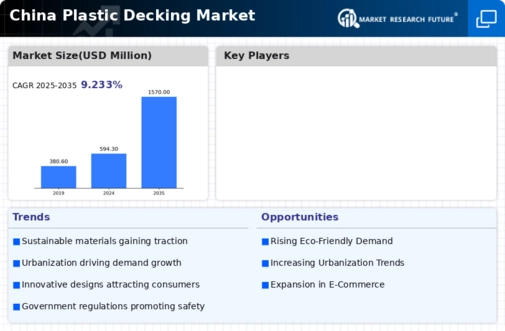Environmental Regulations
In recent years, China has implemented stricter environmental regulations aimed at reducing waste and promoting sustainable practices. These regulations encourage the use of eco-friendly materials, which has positively impacted the plastic decking market. Manufacturers are increasingly adopting recycled materials in their products, aligning with government initiatives to minimize environmental footprints. As of 2025, it is estimated that around 30% of decking materials used in new constructions will be made from recycled plastics. This shift not only meets regulatory requirements but also appeals to environmentally conscious consumers, thereby expanding the market for plastic decking. The industry's ability to adapt to these regulations is likely to enhance its competitiveness and market share.
Rising Construction Activities
The plastic decking market in China is experiencing a surge due to increasing construction activities across residential and commercial sectors. The government has been investing heavily in infrastructure projects, which has led to a heightened demand for durable and low-maintenance materials like plastic decking. In 2025, the construction industry in China is projected to grow by approximately 6%, further driving the need for innovative building materials. This growth is likely to be fueled by urbanization trends, as more people move to cities, necessitating the development of new housing and recreational spaces. Consequently, the plastic decking market is poised to benefit from this construction boom, as builders and developers seek sustainable and cost-effective solutions for outdoor spaces.
Innovations in Material Technology
Innovations in material technology are playing a crucial role in shaping the plastic decking market in China. Advances in manufacturing processes have led to the development of more durable, weather-resistant, and aesthetically pleasing decking options. For instance, new composite materials that combine plastic with wood fibers are gaining popularity due to their enhanced performance characteristics. As of 2025, it is anticipated that these innovative products will capture a significant portion of the market, appealing to consumers looking for high-quality outdoor solutions. The continuous evolution of material technology not only meets consumer demands but also positions the plastic decking market for sustained growth in a competitive landscape.
Expansion of Retail and Distribution Channels
The plastic decking market in China is benefiting from the expansion of retail and distribution channels. With the rise of e-commerce and home improvement stores, consumers have greater access to a variety of decking options. This increased availability is likely to drive sales, as customers can easily compare products and prices. In 2025, it is projected that online sales of decking materials will account for nearly 20% of the total market share. Additionally, partnerships between manufacturers and retailers are enhancing product visibility and consumer awareness. As distribution networks continue to grow, the plastic decking market is expected to thrive, catering to a broader audience.
Consumer Preference for Low-Maintenance Solutions
There is a noticeable shift in consumer preferences towards low-maintenance outdoor solutions, which is significantly influencing the plastic decking market. Homeowners are increasingly seeking materials that require minimal upkeep, such as plastic decking, which does not need regular staining or sealing. This trend is particularly evident in urban areas where busy lifestyles leave little time for maintenance. Market data indicates that the demand for low-maintenance decking solutions has risen by approximately 25% in the last two years. As consumers prioritize convenience and durability, the plastic decking market is likely to see continued growth, as manufacturers innovate to meet these evolving preferences.











Leave a Comment